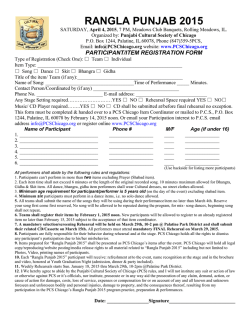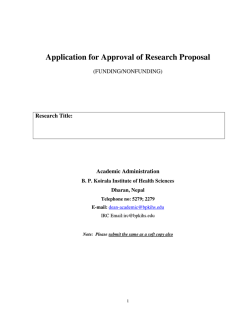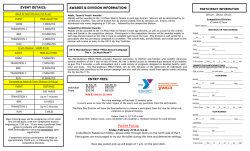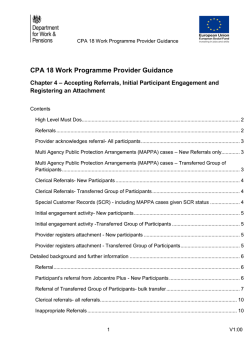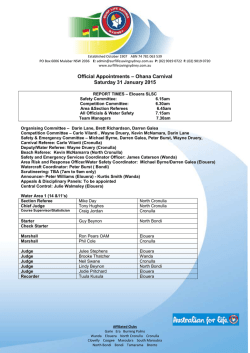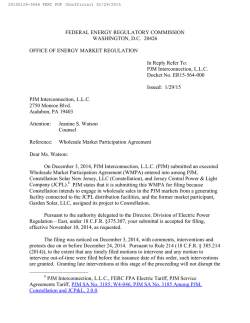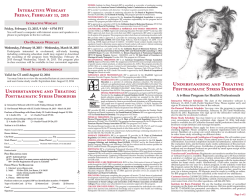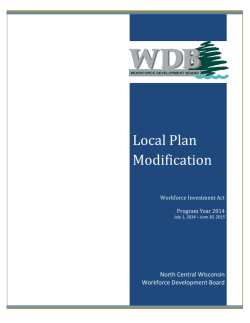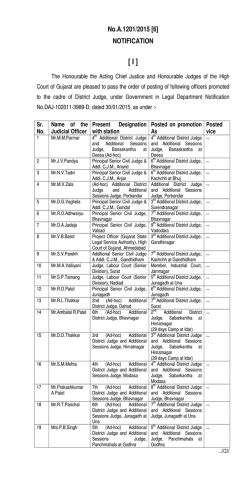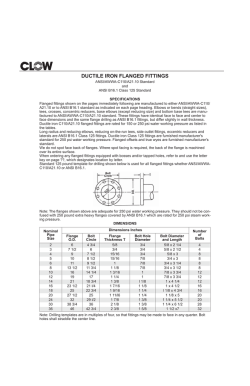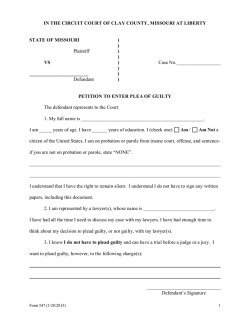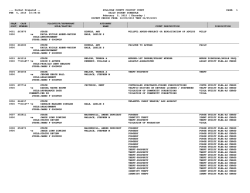
INTERNATIONAL BUSINESS PLAN EVENT 2015
INTERNATIONAL BUSINESS PLAN EVENT 2015 The International Business Plan Event involves the development of a proposal to start a new business venture in an international setting, an analysis of the international business situation, a description of how BUSINESS the proposed venture will operate, and detailed plans for financing the business through its first three MANAGEMENT + years of operation. Any type of business may be used. The purpose of the International Business Plan ADMINISTRATION Event is to provide an opportunity for the participants to n apply entrepreneurship knowledge and skills in an international setting n prepare a written proposal for a new business venture (a new business or a new product or service of an existing business) EVENT OVERVIEW 1 to 3 PARTICIPANTS n PAGES ALLOWED PRESENTATION TIME The project consists of two major parts: the written document and the oral presentation. The written document will account for 60 points and the oral presentation will account for the remaining 40 of the total 100 points. Each event entry will be composed of one to three members of the DECA chapter. All participants must present the project to the judge. All participants must respond to questions. n The body of the written entry must be limited to 30 numbered pages, including the appendix (if an appendix is attached), but excluding the title page and the table of contents. nThe Written Event Statement of Assurances must be signed and submitted with the entry. Do not include it in the page numbering. n The participants may bring all visual aids to the event briefing. Only approved visual aids may be used during the presentation. n The oral presentation may be a maximum 15 minutes in length. The first 10 minutes will include an explanation and description of the project followed by 5 minutes for the judge’s questions. n The judge will evaluate the presentation, focusing on the effectiveness of public speaking and presentation skills and how well the participants respond to questions that the judge may ask during the 5 minutes following the presentation. n BUSINESS MANAGEMENT & ENTREPRENEURSHIP EVENTS KNOWLEDGE AND SKILLS DEVELOPED Participants will demonstrate knowledge and skills needed to address the components of the project as described in the content outline and evaluation forms. Participants will also develop many 21st century skills, in the following categories, desired by today’s employers: n n n Communication and Collaboration Critical Thinking and Problem Solving n Information Literacy n Leadership and Responsibility n Productivity and Accountability n Creativity and Innovation Flexibility and Adaptability n Initiative and Self-direction n Media Literacy n Social and Cross-cultural Skills A crosswalk is available at www.deca.org that shows which 21st century skills are developed by participating in each competitive event. Many Common Core Standards for Mathematics and English Language Arts & Literacy are supported by participation in DECA’s competitive events. Crosswalks are available at www.deca.org that show which common core standards are supported by participating in each competitive event. FORMAT GUIDELINES FOR THE WRITTEN ENTRY The written entry must follow these specifications. Refer also to the Written Entry Checklist and the Written Entry Evaluation Form. A Written Event Statement of Assurances must be signed and submitted with the entry. Do not include it in the page numbering. (Continued on next page) 117 IBP–2015 Title page. The first page of the written entry is the title page. It must include in any order, but is not limited to, the following: INTERNATIONAL BUSINESS PLAN EVENT Type of business proposed Name of DECA chapter Name of high school School address City, State/Province, ZIP/Postal Code Names of the participants Date The title page will not be numbered. Table of contents. The table of contents should follow the title page. All activities or original research described in this entry must take place between the immediate past International Career Development Conference and the upcoming Chartered Association Career Development Conference. The table of contents may be single-spaced and may be one or more pages long. The table of contents page(s) will not be numbered. Body of the written entry. The body of the written entry begins with Section I, Executive Summary and continues in the sequence outlined here. The first page of the body is numbered 1 and all following pages are numbered in sequence. Page numbers continue through the bibliography (required) and the appendix (optional). Follow this outline when you write your entry. Points for each section are shown on the Written Entry Evaluation Form. Each section must be titled, including the bibliography and the appendix. I. EXECUTIVE SUMMARY One-page description of the project II.INTRODUCTION The type of business, product or service proposed and a brief description. A brief description of the country proposed for trade, the rationale for selecting the country, identification of existing trade barriers, identification of sources of information (research sources and interviews). III. ANALYSIS OF THE INTERNATIONAL BUSINESS SITUATION A. Economic, political and legal analysis of the trading country 1. Describe the trading country’s economic system, economic information important to your proposed business/product/service, the level of foreign investment in that country 2. Describe the trading country’s governmental structure and stability, how the government controls trade and private business 3. Describe laws and/or governmental agencies that affect your business/product/service [i.e., labor laws, trade laws (U.S.A. and/or Canada and foreign)] B. Trade area and cultural analysis 1. Geographic and demographic information, important customs and traditions, other pertinent cultural information, competitive advantages and disadvantages of the proposed product and/or service 2. Market segment analysis target market (age, income level, population estimate, other specific demographic and economic information) customer buying behavior related to the proposed product and or service 3. Analysis of the potential location—importance and requirements of each trade document required by the U.S.A. and/or Canada and the country of choice IV. PLANNED OPERATION OF THE PROPOSED BUSINESS/PRODUCT/SERVICE A. Proposed organization Type of ownership and rationale; advantages/disadvantages of the type of ownership selected; start-up steps to form the business; planned personnel (or functional) needs; proposed staffing to handle managerial, financial, marketing, legal, production (if applicable) functions; proposed organization chart, brief job descriptions, if necessary B. Proposed product/service 1. Details of the product(s)/service(s) to be offered; include potential suppliers, manufacturing plans, inventory policies, if applicable. If the business is a service business, appropriate information about plans to provide the service, including necessary supplies 2. How the product/supplies will be transported to/from the home country; costs, benefits, risks of the transportation method; documents needed to transport the product/supplies 118 IBP–2015 C. Proposed strategies 1. Proposed pricing policies, what currency will be used, costs, markups, markdowns, relation to competition, factors that could affect the price of the product (e.g., competition, political conditions, taxes, tariffs, transportation costs) 2. Proposed promotional program, promotional activity(ies), media availability, costs, one-year promotional plan outline V. PLANNED FINANCING Projected income and expenses (The following are recommended items to be included. You may select the appropriate items for your business.) A. Projected income statements for first year’s operation (sales, expenses, profit/loss) B. Projected balance sheet for the end of the first year C. A brief narrative description of the planned growth of the proposed business, including financial resources, needs and a brief three-year plan projection VI.BIBLIOGRAPHY VII.APPENDIX An appendix is optional. Include in the appendix any exhibits appropriate to the written entry, but not important enough to include in the body; these might include sample questionnaires used, letters sent and received, general background data, etc. CHECKLIST STANDARDS In addition to following the outline provided, when preparing your written entry you must observe all of the following rules. The purpose of these rules is to make competition as fair as possible among the participant teams. Refer to the Written Entry Checklist on page 54 for a complete list of standards. PRESENTATION GUIDELINES n n n n n n n n BUSINESS MANAGEMENT & ENTREPRENEURSHIP EVENTS n Prior to the presentation, the judge will evaluate the written portion of the entry. The major emphasis of the written entry is on the content. Drawings, illustrations and graphic presentations (where allowed) will be judged for clarity, not artistic value. The participants have been asked to prepare a proposal for a new business venture in an international setting. Playing the role of a business executive, the judge will evaluate the written document and then interview the participants, as if he/she were actually going to approve (or disapprove) the proposal. The participants will present the plan to the judge in a 15-minute presentation worth 40 points. (See Presentation Judging.) The presentation begins immediately after the introduction of the participants to the judge by the adult assistant. Each participant must take part in the presentation. The participants will spend not more than 10 minutes, at the beginning of the presentation, describing the plan. Each participant may bring a copy of the written entry or note cards pertaining to the written entry and use as reference during the presentation. The judge will spend the remaining 5 minutes questioning the participants. (See Presentation Evaluation Form.) Each participant must respond to at least one question posed by the judge. The participants may use the following items during the oral presentation: – not more than three (3) standard-sized posters not to exceed 22 1/2 inches by 30 1/2 inches each. Participants may use both sides of the posters, but all attachments must fit within the poster dimensions. – one (1) standard-sized presentation display board not to exceed 36 1/2 inches by 48 1/2 inches. – one (1) desktop flip chart presentation easel 12 inches by 10 inches (dimensions of the page). – one (1) personal laptop computer. – cell phones/smartphones, iPods/MP3 players, iPads/tablets or any type of a hand-held, information sharing device will be allowed in written events if applicable to the presentation. – sound, as long as the volume is kept at a conversational level. Only visual aids that can be easily carried to the presentation by the actual participants will be permitted, and the participants themselves must set up the visuals. No set-up time will be allowed. Participants must furnish their own materials and equipment. No electrical power or Internet connection will be supplied. (Continued on next page) 119 IBP–2015 n Materials appropriate to the situation may be handed to or left with judges in all competitive events. Items of monetary value may be handed to but may not be left with judges. Items such as flyers, brochures, pamphlets and business cards may be handed to or left with the judge. No food or drinks allowed. n If any of these rules are violated, the adult assistant must be notified by the judge. PRESENTATION JUDGING Participants will make a 15-minute presentation to you. You are role-playing a business executive. You may refer to the written entry, or to your notes, during the presentation. During the first 10 minutes of the presentation (after introductions), the participants will describe the proposal and make the request for approval. Allow the participants to complete this portion without interruption, unless you are asked to respond. Each participant must take part in the presentation. During the final 5 minutes, you may question the participants. At least one question must be addressed to each participant. To ensure fairness, you must ask each participant or group of participants the same three questions (based on the Presentation Evaluation Form): 1. one question on analyzing the international business situation 2. one question on planning the operation of the proposed business 3. one question on planning the financing and projecting income and expenses You should prepare these three questions after you have evaluated the written entries but before the presentation begins. After asking the three questions, you may ask additional questions that seem appropriate, based on your notes or on the written entry itself (to which you may refer during the presentation). At the conclusion of the presentation, thank the participants. Then complete the Presentation Evaluation Form, making sure to record a score for all categories. Maximum score for the presentation is 40 points. 120 IBP–2015 INTERNATIONAL BUSINESS PLAN EVENT, 2015 Participant:_____________________________________________ Participant:_____________________________________________ WRITTEN ENTRY EVALUATION FORM Participant:_____________________________________________ I.D. Number:____________________________________________ Please refer to Format Guidelines for the Written Entry for a more detailed explanation of these items. Little/No Value Below Meets Exceeds Expectations Expectations Expectations Judged Score EXECUTIVE SUMMARY 1. One-page description of the project 0-1 2 3 4 0-1 2 3 4 INTRODUCTION 2. The type of business, product and/or service with a description; description of the country; rationale for selecting the country; identification of existing trade barriers; sources of information ANALYSIS OF THE INTERNATIONAL BUSINESS SITUATION Economic, political and legal analysis 3. Description of the country’s economic system 0-1 2 3 4 4. Description of the country’s governmental structure and stability 0-1 2 3 4 5. Description of the laws affecting the product and/or service 0-1 2 3 4 Geographic and demographic information, important customs and traditions, other pertinent cultural information, competitive advantages and disadvantages 0-1 2 3 4 7. Market segment analysis 0-1 2 3 4 8. Analysis of the potential location 0-1 2 3 4 Trade area and cultural analysis 6. BUSINESS MANAGEMENT & ENTREPRENEURSHIP EVENTS PLANNED OPERATION OF THE PROPOSED BUSINESS/PRODUCT/SERVICE 9. Proposed organization 0-1 2 3 4 Proposed product/service(s) 10. Details of the product/service(s) 0-1 2 3 4 11. How the product/service(s) will be transported to/from the home country; documentation 0-1 2 3 4 Proposed strategies 12. Proposed pricing policies 0-1 2 3 4 13. Proposed promotional program 0-1 2 3 4 0-1 2 3 4 0-1 2 3 4 PLANNED FINANCING 14. Projected income and expenses APPEARANCE AND WORD USAGE 15. Professional layout, neatness, proper grammar, spelling and word usage Written Entry Total Points (maximum 60 points): Judge: A B C D E F G H I J (circle one) 121 IBP–2015 INTERNATIONAL BUSINESS PLAN EVENT, 2015 Participant:_____________________________________________ Participant:_____________________________________________ ORAL PRESENTATION EVALUATION FORM Participant:_____________________________________________ I.D. Number:____________________________________________ Little/No Value 1. Opening presentation: description of the project; organization, clarity and effectiveness of the presentation 2. Below Meets Exceeds Expectations Expectations Expectations 0-1-2 3-4-5 6-7 8-9 Question on the analysis of the international business situation 0-1 2-3 4-5 6-7 3. Question on the planned operation of the proposed business 0-1 2-3 4-5 6-7 4. Planned financing, projected income and expenses 0-1 2-3 4-5 6-7 5. To what extent did the participant(s) demonstrate professional appearance, poise and confidence? 0-1 2-3 4 5 6. Overall performance, presentation technique, effective use of visual aids and participation of all 0-1 2-3 4 5 Presentation Total Points (maximum 40 points): RECAP: WRITTEN ENTRY (60): PRESENTATION (40): SUBTOTAL (100): LESS PENALTY POINTS: TOTAL SCORE: Judge: 122 A B C D E F G H I J (circle one) Judged Score WRITTEN EVENT STATEMENT OF ASSURANCES AND ACADEMIC INTEGRITY, 2015 Research and report writing are important elements of modern business activities. Great care must be taken to assure that the highest ethical standards are maintained by those engaging in research and report writing. To reinforce the importance of these standards, all written entries in DECA’s Competitive Events Program must submit this statement as part of the entry. The statement must be signed by the DECA member(s) and the chapter advisor. I understand the following requirements are set forth by DECA Inc. for all Competitive Event entries containing a written component. These requirements are additional to the general rules and regulations published by DECA Inc. By signing this statement, I certify that all are true and accurate as they relate to this entry. 1. The contents of this entry are the results of my work or, in the case of a team project, the work of current members of this DECA chapter. 2. No part of this entry has previously been entered in competition. 3. This entry has not been submitted in another DECA competitive event. 4. Credit for all secondary research has been given to the original author through the project’s bibliography, footnotes or endnotes. 5.All activities or original research procedures described in this entry are accurate depictions of my efforts or, in the case of team projects, the efforts of my team. 6.All activities or original research described in this entry took place during this school year or the timeline specified in the Event Guidelines. 7. I understand that DECA has the right to publish all or part of this entry. Should DECA elect to publish the entire entry, I will receive an honorarium from DECA. Chapters or individuals with extenuating circumstances may appeal the right to publish the entry to the executive committee of the board of directors prior to submission of the project for competition. This statement of assurances must be signed by all participants and the chapter advisor, and submitted with the entry, or the entry will be given 15 penalty points. _________________________________________________ __________________________________________________ Participant’s Signature Participant’s Signature _________________________________________________ Participant’s Signature ___________________________________________________________________________________________________________________________ Print/Type Participant Name(s) ___________________________________________________________________________________________________________ Competitive Event Name School Chartered Association (State/Province) To the best of my knowledge, I verify that the above statements are true and that the student’s (students’) work does not constitute plagiarism. _________________________________________________ Chapter Advisor’s Name _________________________________________________ Chapter Advisor’s Signature _________________________________________________ Chapter Advisor’s Email Hole punch and place in front of the written entry. Do not count as a page. PROJECT ORIGINALITY In many written events, chapters have settled on a strategy that uses the same well-developed projects year after year. Succeeding chapter teams often take the previous year’s successful project and seek to improve it. If that strategy works in achieving a chapter’s goals and the experience teaches the principles of DECA, the strategy serves the chapter, the community and DECA well. Chapters submitting entries for chapter team events, however, should be challenged to do more than update the previous year’s written project. Project committees should avoid even reviewing the previous year’s entry. Judges (whose assignment is to evaluate a project according to established guidelines) will be impressed by the originality of a chapter’s project. Plagiarism of projects judged previously will automatically disqualify a chapter from competition and eligibility for awards. 55 WRITTEN ENTRY CHECKLIST, 2015 Event:___________________________ Participant:_______________________ Participant:_______________________ Participant:_______________________ I.D. Number:______________________ Please refer to Format Guidelines for the Written Entry for a more detailed explanation of these items. Penalty PointsPage CheckedAssessed No. 1. The Written Event Statement of Assurances must be signed and submitted with the entry. 2. ________15 ________ Entries submitted in an official DECA written event folio. Folios are available from DECA Images (FOLIO). No markings, tape or other material should be attached to the folio. One photocopy or the original typed document must be submitted. Participants may keep a copy for use in the presentation. ________5 ________ 3. Sheet protectors may not be used. ________5 ________ 4. Limited to the number of pages specified in the guidelines (plus the title page and the table of contents). 5. ________ 5 (per page) ________ All pages are numbered in sequence starting with the executive summary and ending with the final page of the appendix. Do not use separate sheets between sections or as title pages for sections. 6. ________5 ________ Major content must be at least double-spaced (not space-and-a-half). Title page, table of contents, executive summary, bibliography, appendix, footnotes, long quotes (more than three typed lines), material in tables, figures, exhibits, lists, headings, sample letters, forms, etc., may be single-spaced. 7. Entry must be typed/word processed. Handwritten corrections will be penalized. Charts and graphs may be handwritten. 8 . ________ 5_______ Paper is 81/2 inches x 11 inches. No fold-outs, attachments or tabs used. 9. ________5 ________ ________5 ________ The written entry follows the format guidelines. Additional subsections are permitted in the body of the written entry. Total ________5 ________ Penalty Points Assessed A check indicates that the item has been examined. A circled number indicates that an infraction has been noted. A page number indicates the location of the infraction. 54 ______
© Copyright 2025

